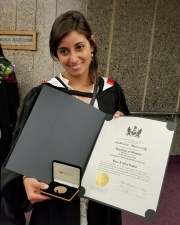Kara Vogler

B. Sc. (Honours)
B.Sc. (Honours) Thesis
BEDFORMS IN WAVE–FORCED NEARSHORE ENVIRONMENTS:
OBSERVATIONS WITH A PROTOTYPE HUMAN-POWERED SURFACE
VEHICLE
(PDF - 23 Mb)
Bedforms in nearshore environments are undulatory sedimentary structures formed by wave-forced fluid-sediment interactions at the seabed. Signature characteristics imprinted on the sediment fabric may be used to infer environmental conditions in the past by comparison to bedforms in the geologic record. Lunate megaripples and cross-ripples are bedforms with complex geometries that have been observed in nearshore environments, however they are not well studied in the literature and the conditions required for their formation are unclear. Previous surveying methods have recorded observations using instruments installed in the seafloor, which can disturb the sediment and obstruct fluid flow. The purpose of this study is to refine methodology for observing lunate megaripples and cross-ripples noninvasively. The study site, Crystal Crescent Beach, in Sambro, Nova Scotia, was selected for its sandy bottom and clear water. A low cost, human-powered surface vehicle was constructed using a surfboard as the platform for mounting (1) a video imaging device to record bedform morphologies at varying depths, and (2) a sonar device connected to GPS to detect and document ocean floor topography. Surveys were conducted prior to a storm event, during the event, then after the event to observe bedform transformation. Sand samples were obtained for analyzing grain size characteristics of the bedforms. Weather, wind, and wave conditions were recorded before, during, and following fieldwork to document potential physical conditions associated with bed geometries. Still frames from videos of pre-storm seabed conditions compared to videos of poststorm conditions showed recognizably different bedforms. In videos acquired during the storm, suspended sediment in the water column made it difficult to observe the seafloor. Analysis of weather data confirmed that large wave heights were associated with high wind speed, and grain size analysis showed that more complex, threedimensional bedforms occurred where there was variability in grain size. Figures created using sonar data illustrated an overall change in beach geometry throughout the storm event. Overall, observations were relatively high quality, allowing for identification distinct ripple geometries and change in overall bed state associated with growth and decay of storm wave conditions. This study demonstrated potential for examining bedforms using low-cost, human-powered, instrumented surface vehicles. Therefore, despite being an initial attempt, this study can be used as a basis for further studies of bedform development in nearshore environments.
Keywords: Bedform, lunate megaripple, cross ripple, high energy, nearshore
Pages: 74
Supervisor: Alex Hay



